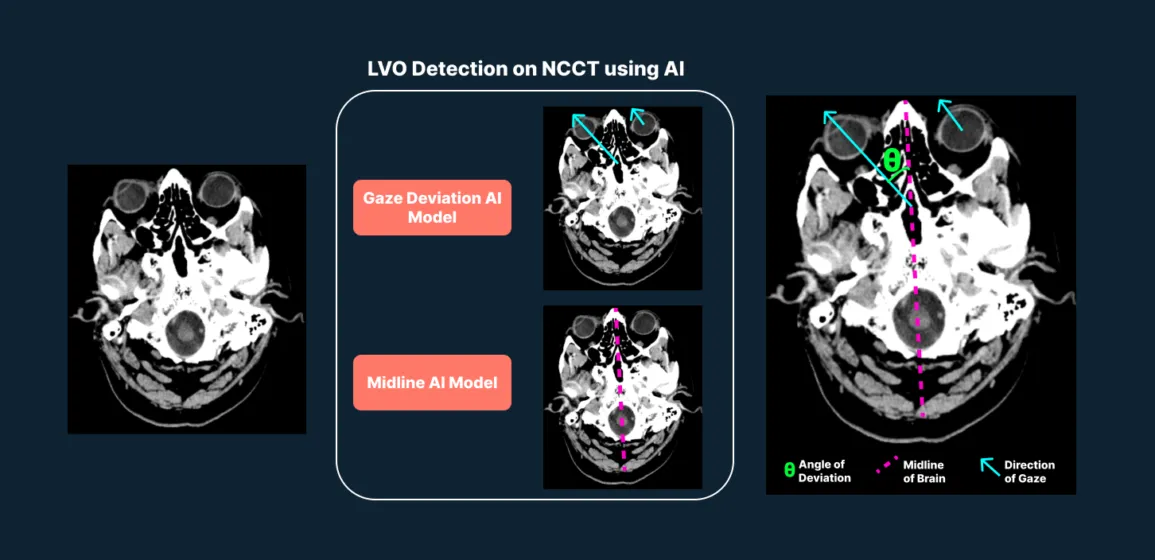Introduction

Back
Strokes occur when blood supply to the brain is interrupted or reduced, depriving brain tissue of oxygen and nutrients. It is estimated that a patient can lose 1.9 million neurons each minute when a stroke is untreated. So, the treatment of stroke is a medical emergency that requires early intervention to minimize brain damage and complications. Furthermore, a stroke caused by emergent large vessel occlusion (LVO) requires a much more prompt identification to improve clinical outcomes.
Neuro interventionalists need to activate their operating rooms to prepare candidates identified for endovascular therapy (EVT) as soon as possible. As a result, identifying imaging findings on non-contrast computed tomography (NCCT) that are predictive of LVO would aid in identifying potential EVT candidates. We present and validate gaze deviation as an indicator to detect LVO using NCCT. In addition, we offer an Artificial Intelligence (AI) algorithm to detect this indicator.
What is LVO?
Large vessel occlusion (LVO) stroke is caused by a blockage in one of the following brain vessels:
- Internal Carotid Artery (ICA)
- ICA terminus (T-lesion; T occlusion)
- Middle Cerebral Artery (MCA)
- M1 MCA
- Vertebral Artery
- Basilar Artery
Image source: Science direct
What is LVO?
Large vessel occlusion (LVO) stroke is caused by a blockage in one of the following brain vessels:
- Internal Carotid Artery (ICA)
- ICA terminus (T-lesion; T occlusion)
- Middle Cerebral Artery (MCA)
- M1 MCA
- Vertebral Artery
- Basilar Artery
Image source: Science direct
LVO strokes are considered one of the more severe kinds of strokes, accounting for approximately 24% to 46% of acute ischemic strokes. For this reason, acute LVO stroke patients often need to be treated at comprehensive centers that are equipped to handle LVOs.
Endovascular Treatment (EVT)
EVT is a treatment given to patients with acute ischemic stroke. Using this treatment, clots in large vessels are removed, helping deliver better outcomes. EVT evaluation needs to be done at the earliest for the patients that meet the criteria and are eligible. Early access to EVT increases better outcomes for patients. The timeframe to perform is usually between 16 – 24 hours in most acute ischemic cases.
Image Source: PennMedicine
GOAL OF EVT
Since it is important to perform this procedure as early as possible, how do we get there?
LVO detection on NCCT
There is a 3 point step to consider for this:
- Absence of blood
- Hyperdense vessel sign or dot sign
- Gaze deviation (often overlooked on NCCT)
Gaze deviation and its relationship with acute stroke
Several studies suggest that gaze deviation is largely associated with the presence of LVO [1,2,3].
Stroke patients with eye deviation on admission CT have higher rates of disability/death and hemorrhagic transformation. Consistent assessment and documentation of radiological eye deviation on acute stroke CT scan may help with prognostication [4].
AI algorithm to identify gaze deviation
We developed an AI algorithm that reports the presence of gaze deviation given an NCCT scan. Such AI algorithms have tremendous potential to aid in this triage process. The AI algorithm was trained using a set of scans to identify gaze direction and midline of the brain. The gaze deviation is calculated by measuring the angle between the gaze direction and the midline of the brain. We used this AI algorithm to identify clinical symptoms of ipsiversive gaze deviation in stroke patients with LVO treated with EVT. The AI algorithm has a sensitivity and specificity of 80.8% and 80.1% to detect LVO using gaze deviation as the sole indicator. The test set had 150 scans with LVO-positive cases where thrombectomy was performed.
Discussion
Ipsiversive Gaze deviation on NCCT is a good predictor of LVO due to proximal vessel occlusions in ICA terminus and M1 occlusions. However, it is a poor predictor of LVO due to M2 occlusion. We report an AI algorithm that can identify this clinical sign on NCCT. These findings can aid in the triage of LVO patients and expedite the identification of EVT candidates.
We are presenting this AI method at SNIS 2022, Toronto. Please attend our oral presentation on 28th July 2022 at 12:15 PM (Toronto time).
Upadhyay, Ujjwal & Golla, Satish & Kumar, Shubham & Szweda, Kamila & Shahripour, Reza & Tarpley, Jason. (2022). Society of NeuroInterventional Surgery SNIS
References